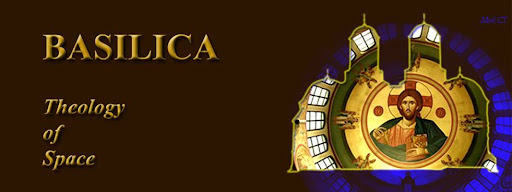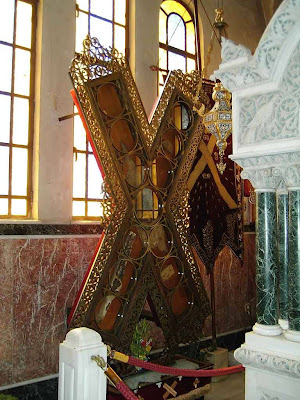Tuesday, November 30, 2010
Saint Apostol Andrew cathedral, Patras, Greece
Saint Andrew is the Patron Saint of the city of Patras, Scotland, Ukraine, Russia, Romania, Patras in Greece, Amalfi in Italy, Luqa in Malta, and Esgueira in Portugal. He was also the patron saint of Prussia.
Patras is a city in Achaia , North Peloponnese. There the Apostol spent his last years of his life untill his martyric death. As the first to be called by Jesus Christ into his service, St. Andrew commands a reverence a degree greater than those who have followed. For this reason, St. Andrew is called Protokletos, or "First-called."
St. Andrew, like his brother St. Peter, was a fisherman, a toiler with net and boat recognised in the Psalms of the Old Testament as one of those "who go down to the sea in ships, that do business in great waters; these see the works of the Lord and his wonders in the deep." His love of the sea stemmed from his love of the Creator who made it, and the perils of the sea which he challenged daily forged the character with which he boldly assailed the seas of ignorance and paganism in the sacred trust that had been placed in his keeping.
St. Andrew, who lived in the Holy Land in the ancient city of Bethsaida, accepted Christ with all his heart and after a discipleship with St. John the Baptist went forth to become one of the greatest missionaries in all history. When the apostles drew lots to determine their sphere of labour for the Saviour, St. Andrew exulted in his mission to preach in Asia Minor, part of Greece, and an area along the coast of the Black Sea, including its gateway, the city now known as Istanbul, or Constantinople.
Wherever St. Andrew went he attracted throngs of people who thirsted for a spiritual knowledge. His message of deliverance was so eloquently convincing, even to hostile minds, that he is credited with having converted countless thousands to Christianity in a day when mass media did not exist. As an apostle, his only tools were his power of oratory and his love for Jesus, and his only press agent was the word of mouth of those privileged to hear his homilies.
St. Andrew came to Jerusalem for the First Synod of the Apostles, about 50 AD, another historic first for him and the other apostles, some of whom he had not yet met. There he rejoiced in joining the great St. Peter together with those but for whom Christianity might never have become the glorious human experience it is today. Out of the Synod, the apostles went forth with renewed vigour to establish the ecclesiastical system.
St. Andrew alone is credited with having set up parishes throughout Asia Minor, in Pontos, Bithynia, Thrace, Macedonia, Greece, Scythia (Russia, where he is still regarded as patron saint) and in the capital city of Byzantium. It was in Byzantium that St. Andrew ordained Stachys as first bishop of Byzantium (later Constantinople), thereby establishing an unbroken line of 270 patriarchs down to the present day Patriarch Bartholomeos 1st. From Byzantium, St. Andrew went on to more glory through his compelling oratory and power of healing through Jesus Christ. He eventually found himself in Achaia, in the city of Patras, where he was to suffer death.
St. Andrew committed the grave crime in the eyes of the state of converting Maximilla, wife of the ruler Aigeates, to Christianity. Despite the fact that he was then eighty years old, it was ordered that he be put to death by being nailed upside down to an X-shaped cross. After three days of agony on this vile device, St. Andrew died. The great fisherman had cast his net for Christ for the last time.
In 357 the relics of Saint Andrew were removed from Patras and deposited in the church of the Holy Apostles in Constantinople.
The head of the saint, was given by the Byzantine despot Thomas Palaeologus to Pope Pius II in 1461.On 24 September 1964, in an ecumenical gesture, the head was returned to the people of Patras by the pope Pope Paul VI.
The relics, which consist of the small finger and part of the top of the cranium of Saint Andrew, have since that time been kept in the Church of St. Andrew at Patras in a special tomb, and are reverenced in a special ceremony every November 30and . On 24 September 1964, in an ecumenical gesture, the head was returned to the people of Patras by the pope.
Labels:
|C| Churches
Monday, November 29, 2010
Unholy Conversion As Church Becomes A Tesco
Temple of commerce: A Tesco Express store has opened in Bournemouth, Dorset after the supermarket giant purchased a former Methodist church
Prophet exchanged for profit as Tesco opens latest convenience shop in a church!
(Bournemouth, Dorset, UK)
Shoppers who pray for cheaper groceries might just get what they wish for after a branch of Tesco opened in a former church. The building has been drastically altered to sell groceries underneath its original ornate stained glass windows. The former Westbourne Methodist Church is now selling food, alcohol, cigarettes and lottery tickets after the retail giant moved in. Pews have been stripped out in favour of checkouts in the controversial conversion to a Tesco Express. The move has upset some members of the community, who have criticised the latest expansion of the multi-national supermarket. The Reverend Dr Bob McKinley, former minister at the church, said it was 'sad' to see the building become a shop - but that the church had no control over whom the building was sold to. He said: 'Our main concern was the people. Although it is sad, it is only a building. 'You could say it is not appropriate to have a Tesco Express in it but once it is sold it is no longer under our control.' James Rippon, a 36-year-old accountant who lives nearby, said: 'It just seems such a shame for this beautiful building to be turned into a Tesco. 'It seems like you can't go anywhere in England today without being within spitting distance of one. 'I understand that having the building empty is no good for anyone, but it seems odd that a former church is being used to sell cigarettes, alcohol and lottery tickets. 'It feels like just another step in the increasing marginalisation of Christianity in our community. 'I suppose it represents people's priorities nowadays - the convenience of being able to buy their bread a few miles closer is more important than prayer and religion.' The decision to open the store has been supported by some members of the Westbourne Traders Association, who hope it will attract more shoppers to the area. But Rob Forbes, owner of family-run Seamoor News, said the Tesco store 'spooks you out.' He said: 'I have to cross myself every time I walk past it.'
Tills ringing, not bells: A worker hands over change to a customer
Altar-ing the church: A customer pays for his purchase at the new shop which has caused some concern in the local community
Biblical characters depicted in ornate stained glass windows now look down on shoppers browsing the aisles in the historic building near Bournemouth. But the conversion of the former Westbourne Methodist Church has divided opinion. Christians opposing the scheme have highlighted a passage in the Bible detailing Jesus' efforts to rid the Temple of Herod, saying 'Get these out of here! Do not make My Father's house a house of merchandise'.
Source
Labels:
|S| Suppressed churches
Wednesday, November 17, 2010
World's tallest Jesus completed in Poland
Work on the world's tallest effigy of Jesus Christ was completed in the small Polish town of Świebodzin at the weekend. A giant 700-ton crane was specially drafted in to lift the figure's outstretched arms and crowned head into place. An earlier attempt some weeks earlier failed when a different crane was unable to lift the the plaster and fiber glass mass. The body of the finished statue measures 33-meters-tall, one meter for each year in Christ's life. A three-meter-tall crown and 16-meter-tall mound bring the figure's total height to 52 meters. The effigy overshadows Rio de Janeiro's Christ the Redeemer, which stands at 39.6 meters tall, and the Cristo de la Concordia in Cochabamba, Bolivia, which stands at 40.44 meters. The project has been the lifelong ambition of Father Sylwester Zawadzki who recovered from two heart attacks during the construction process to finally see his dream realized. “This is the culmination of my life's work as a priest. I felt inspired to fulfill Jesus' will, and today I give thanks to him for allowing me to fulfill his will,” Father Zawadzki, told onlookers and reporters. The statue will be officially consecrated on November 21.
Source
Labels:
|W| World
Thursday, November 4, 2010
The Church of the Resurrection of Christ, St. Petersburg, Russia
This marvelous Russian-style church was built on the spot where Emperor Alexander II was assassinated in March 1881. After assuming power in 1855 in the wake of Russia’s disastrous defeat in the Crimean war against Britain, France and Turkey, Alexander II initiated a number of reforms. In 1861 he freed the Russian serfs (peasants, who were almost enslaved to their owners) from their ties to their masters and undertook a rigorous program of military, judicial and urban reforms, never before attempted in Russia. However, during the second half of his reign Alexander II grew wary of the dangers of his system of reforms, having only barely survived a series of attempts on his life, including an explosion in the Winter Palace and the derailment of a train. Alexander II was finally assassinated in 1881 by a group of revolutionaries, who threw a bomb at his royal carriage.
The decision was taken to build a church on the spot where the Emperor was mortally wounded. The church was built between 1883 and 1907 and was officially called the Resurrection of Christ Church (a.k.a. The Church of Our Savior on Spilled Blood ). The construction of the church was almost entirely funded by the Imperial family and thousands of private donators. Both the interior and exterior of the church is decorated with incredibly detailed mosaics, designed and created by the most prominent Russian artists of the day (V.M. Vasnetsov, M.V. Nesterov and M.A. Vrubel). Interestingly, despite the church’s very obviously Russian aspect, its principle architect, A. Parland, was not even Russian by birth.
The church was closed for services in the 1930s, when the Bolsheviks went on an offensive against religion and destroyed churches all over the country. It remained closed and under restoration for over 30 years and was finally re-opened in 1997 in all its dazzling former glory. The view of the church from Nevsky Prospekt is absolutely breathtaking.
NOTE: Translations of the church’s name vary between guidebooks and include The Church of the Savior on Blood, The Resurrection Church and The Church of the Resurrection of Christ.
Labels:
|C| Churches
Subscribe to:
Posts (Atom)


























